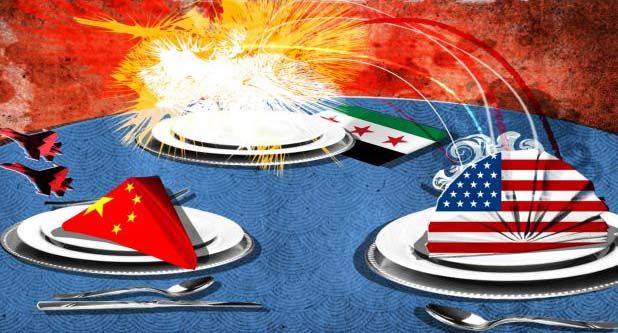Post by kiwithrottlejockey on Apr 11, 2017 12:59:41 GMT 12
An interesting opinion piece published in today's Sydney Morning Herald “hits the nail right on the head!”
Compared to China's President Xi Jinping, Donald Trump is a nothing … a nobody … a total bumbling amateur.
I subscribe to The Washington Post and a number of news articles and commentaries published by that newspaper during the lead-up to the meeting between Trump and Xi Jinping at Mar-a-Lago attracted a huge number of online reader comments. It was staggering how many of those comments were to the effect that Trump is a rank amateur compared to the Chinese President, who would walk all over Trump and give absolutely nothing away. It would appear that those reader comments have turned out to be absolutely right. China will do whatever they wish throughout the Asia region including the South China Sea and leave Trump bumbling behind in their wake. The Chinese have called Trump's bluff and shown the Orange Goblin up for the clown he is. Sooner or later, countries such as Australia and New Zealand will have to make an unpalitable choice on whether to protect their economic interests, or side with their long-time ally.
from The Sydney Morning Herald....
China took a very different message
from Donald Trump's Syria attack
Trump completely misread China's reaction to missiles.
By PETER HARTCHER | 12:01AM - Tuesday, April 11, 2017

Illustration: Dionne Gain.
A THEME echoing through US media in the last few days was that Donald Trump's decision to attack Syria during dinner with China's president was sending a message to Beijing. But what was the message?
It was an obvious act of intimidation, a threat, according to the consensus American interpretation. America is powerful. America is dangerous. America will use force, so watch out.
But the Chinese will interpret it very differently. To Beijing, it is not a threat but a reassurance.
Once again, America is preoccupied with the Middle East. Once again, a US president squares up to confront China but is distracted by the Middle East. Once again, China can make great strategic inroads without serious US resistance.
At his first face to face meetings with Trump last week, Xi Jinping gave the US president nothing. Not the least concession on even the smallest issue.
Remarkably, Trump said it himself. After their first round of talks before dinner on Thursday night, the American leader told reporters: “We had a long discussion already. So far I have gotten nothing. Absolutely nothing. But we have developed a great friendship.”
If Trump thought that his overnight pyrotechnics display in Syria would change Xi's attitude, he was mistaken. Xi merely ignored a year of angry Trump bluster and threats against China.
Point for point on Trump's grievance list: Xi made no concession on trade, no concession on China's allegedly undervalued currency, no concession on North Korea, no concession on Taiwan, no concession on the South China Sea.
At the end of the two-day summit, reporters pressed Trump's Commerce Secretary, Wilbur Ross, on whether Xi had promised to make some infrastructure investments in the US, at least. The American side had been expecting such a “gift”.
“The best gift was [Xi's] presence,” Ross replied. The Chinese agreed to a “100-day plan” to address the trade imbalance, the Americans said, but with no specified goals or outcomes.
The Obama-era dialogue initiative between the two powers was terminated and a replaced with a similar one with a different name. That was about it.

President Donald Trump and Chinese President Xi Jinping at Mar-a-Lago on Friday.
— Photograph: Associated Press.
Not only were China's alleged past transgressions forgotten, a fresh provocation was overlooked. On Thursday, the day the two leaders sat down for their first meeting, a US think tank reported that a Chinese air force jet had been photographed on one of the islands of the South China Sea.
A satellite photographed a Chinese J-11 fighter on Woody Island in the Paracel Island group. “This isn't a first, but it's the first time in a year,” said Greg Poling, director of the Asia Maritime Transparency Initiative (AMTI), part of Washington's Center for Strategic and International Studies.
Only one jet was visible on the Chinese-built runway. “There are likely more in the hangars nearby,” he said. It was photographed on March 29th. Its significance?
This is one of the islands that Xi promised, in a press conference with Barack Obama, would not be militarised. Now it has an airstrip, radars, and reinforced concrete hangars big enough for the biggest bombers in the Chinese air force. And the air force evidently is making use of it.
The Trump administration's reaction? The revelation went unremarked. It received very little media coverage. Nor was the administration pressed by reporters to comment.
Everyone was busy with the Syrian missile attack.
The two leaders did discuss the South China Sea in private. According to US Secretary of State Rex Tillerson, Trump told Xi that the US was opposed to the militarisation of the islands. He urged China to observe norms of international conduct in the area.
But neither US nor Chinese accounts of the meetings referred to any comment by Xi. In other words, China does as it pleases as the US reads out obsolete talking points.
China built all the islands it wanted, installed all the facilities it wanted. It has completed its “iron triangle” of air force bases that straddle the world's biggest commercial artery and Australia's main export route. China is now deploying forces as it chooses, with no hindrance and no comment from the US.
So much for Obama's much-ballyhooed “pivot to Asia”, or “rebalancing”. The contest over the South China Sea is over. China defied the US and it won. China was determined, swift and effective. Trump continues in the Obama mode in the South China Sea — indecisive, distracted and ineffectual.
US allies feeling anxious about America's reliability in the face of China's assertiveness have reason to worry. Trump brings a new level of fickleness to US policy in Asia.
Trump initially signalled a dramatic shift in US intentions when he took a phone call from Taiwan's President Tsai Ing-wen in January. No US president had had direct contact with a Taiwanese leader in 40 years. It was a moment that rocked the Asia-Pacific. He was girding to confront China by favouring Taiwan.
But then he meekly retreated to the orthodoxy in a phone call with Xi in February. And now that the two men have stood toe-to-toe and looked each other in the eye? There was no public reference to Taiwan from either side.
Taiwan, which seemed to be a bold new US priority in January, doesn't even get a mention in April.
What about Trump's message to North Korea? Didn't the missile attack on Syria contan a warning for China's client state?
So far the Trump administration is having the greatest difficulty sorting out the meaning of its message to Syria, with officials contradicting each other over the strategy to flow from the strike.
If there is a message for North Korea, we have to hope that it will be more considered and cogent than the message to Syria. North Korea is not Syria. It is technically still at war with the South. It has spent the past six decades preparing for the next phase.
If struck, North Korea would immediately launch a massive artillery fusillade on Seoul, just 40 kilometres away. It does not need to perfect its nuclear arms to kill millions of South Korean civilians and destroy the US bases on South Korean soil within hours.
China knows exactly its strategy. So Trump's true message to China is that Beijing can get on with it while Trump figures out his own.
• Peter Hartcher is international editor at The Sydney Morning Herald.
__________________________________________________________________________
Related stories:
• Now Trump is just another war president
• Trump lacks commitment to remove Assad
• Trump's big disruption was a much-needed diversion
www.smh.com.au/comment/china-took-a-very-different-message-from-donald-trumps-syria-attack-20170410-gvhm8h.html







